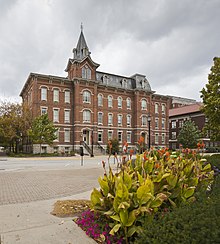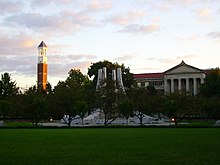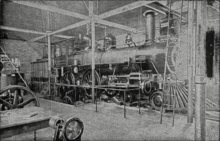
A | B | C | D | E | F | G | H | CH | I | J | K | L | M | N | O | P | Q | R | S | T | U | V | W | X | Y | Z | 0 | 1 | 2 | 3 | 4 | 5 | 6 | 7 | 8 | 9
 | |
| Type | Public land-grant research university |
|---|---|
| Established | May 6, 1869 |
| Founder | John Purdue |
Parent institution | Purdue University System |
| Accreditation | HLC |
Academic affiliations | |
| Endowment | $3.68 billion (system-wide; 2022)[1] |
| Budget | $2.5 billion (2020–21)[2] |
| President | Mung Chiang |
| Provost | Patrick J. Wolfe |
Academic staff | 2,945 (Fall 2022)[3] |
| Students | 52,211 (Fall 2023)[4] |
| Undergraduates | 39,170 (Fall 2023)[4] |
| Postgraduates | 13,041 (Fall 2023)[4] |
| Location | , , 40°25′30″N 86°55′23″W / 40.42500°N 86.92306°W |
| Campus | Small city[6], 2,660 acres (10.8 km2)[5] |
| Newspaper | Purdue Exponent |
| Colors | Old gold and black[7] |
| Nickname | Boilermakers |
Sporting affiliations | NCAA Division I FBS – Big Ten |
| Mascot | |
| Website | www |
Purdue University is a public land-grant research university in West Lafayette, Indiana, and the flagship campus of the Purdue University system.[8] The university was founded in 1869 after Lafayette businessman John Purdue donated land and money to establish a college of science, technology, and agriculture;[9] the first classes were held on September 16, 1874.[9]
Purdue University is a member of the Association of American Universities and is classified among "R1: Doctoral Universities – Very high research activity".[10] Purdue enrolls the largest student body of any individual university campus in Indiana, as well as the ninth-largest foreign student population of any university in the United States.[11] The university is home to the oldest computer science program in the United States.
Purdue is the founding member of the Big Ten Conference and sponsors 18 intercollegiate sports teams. It has been affiliated with 13 Nobel laureates, 1 Turing Award laureate, 1 Bharat Ratna recipient,[a] 27 astronauts,[12] 2 World Food Prize laureates, 3 Pulitzer Prize winners, 18 Olympic medalists, 3 National Medal of Technology and Innovation recipients, 2 National Medal of Science recipients, 3 Presidential Medal of Freedom recipients, 7 members of Congress, 3 U.S. governors, and 2 heads of state.[13][14]
History

In 1865, the Indiana General Assembly voted to take advantage of the Morrill Land-Grant Colleges Act of 1862 and began plans to establish an institution with a focus on agriculture and engineering with the preliminary name of the Indiana Agricultural College.[15] Communities throughout the state offered facilities and funding in bids for the location of the new college. Popular proposals included designating Indiana University or what is now Butler University as Indiana's land-grant, as well as the addition of an agriculture department at what is now Indiana State University. By 1869, Tippecanoe County's offer included $150,000 (equivalent to $3.4 million in 2023) from Lafayette business leader and philanthropist John Purdue; $50,000 from the county; and 100 acres (0.4 km2) of land from John Purdue and local residents.[16]
On May 6, 1869, the General Assembly established the institution in Tippecanoe County as Purdue University, in the name of the principal benefactor. Classes began at Purdue on September 16, 1874, with six instructors and 39 students.[9] Professor John S. Hougham was Purdue's first faculty member and served as acting president between the administrations of presidents Shortridge and White.[9][17] A campus of five buildings was completed by the end of 1874.[18] In 1875, Sarah A. Oren, the State Librarian of Indiana, was appointed professor of botany.[19]
Purdue issued its first degree, a Bachelor of Science in chemistry, in 1875. The first female student was admitted that autumn.[20][21]
Emerson E. White, the university's president from 1876 to 1883, followed a strict interpretation of the Morrill Act. Rather than emulate the classical universities, White believed Purdue should be an "industrial college" and devote its resources toward providing a broad, liberal education with an emphasis on science, technology, and agriculture.[22]
Part of White's plan to distinguish Purdue from classical universities included a controversial attempt to ban fraternities, which was ultimately overturned by the Indiana Supreme Court. White resigned in protest.[23] The next president, James H. Smart, is remembered for his call in 1894 to rebuild the original Heavilon Hall "one brick higher" after it had been destroyed by a fire.[24]
By the end of the nineteenth century, the university was organized into schools of agriculture, engineering (mechanical, civil, and electrical), and pharmacy; former U.S. President Benjamin Harrison served on the board of trustees.[25] Purdue's engineering laboratories included testing facilities for a locomotive, and for a Corliss steam engine—one of the most efficient engines of the time. Programs in education and home economics were soon established, as well as a short-lived school of medicine. By 1925, Purdue had the largest undergraduate engineering enrollment in the country, a status it would keep for half a century.[26]
President Edward C. Elliott oversaw a campus building program between the world wars. Inventor, alumnus, and trustee David E. Ross coordinated several fundraisers, donated lands to the university, and was instrumental in establishing the Purdue Research Foundation. Ross's gifts and fundraisers supported such projects as Ross–Ade Stadium, the Memorial Union, a civil engineering surveying camp, and Purdue University Airport. Purdue Airport was the country's first university-owned airport and the site of the country's first college-credit flight training courses.[27]
Amelia Earhart joined the Purdue faculty in 1935 as a consultant for these flight courses and as a counselor on women's careers. In 1936, the Purdue Research Foundation provided the funds for the Lockheed Electra 10-E Earhart flew on her attempted round-the-world flight.[28]

Every school and department at the university was involved in some type of military research or training during World War II.[29] During a project on radar receivers, Purdue physicists discovered properties of germanium that led to the making of the first transistor.[30][31] The Army and the Navy conducted training programs at Purdue and more than 17,500 students, staff, and alumni served in the armed forces.[32] Purdue set up about a hundred centers throughout Indiana to train skilled workers for defense industries.[33] As veterans returned to the university under the G.I. Bill, first-year classes were taught at some of these sites to alleviate the demand for campus space. Four of these sites are now degree-granting regional campuses of the Purdue University system. On-campus housing became racially desegregated in 1947.[34][35]
After the war, a decade-long construction program emphasized science and research. In the late 1950s and early 1960s the university established programs in veterinary medicine, industrial management, and nursing, as well as the first computer science department in the United States.[36] Undergraduate humanities courses were strengthened, graduate-level study in these areas were slowly established. Purdue awarded its first Bachelor of Arts degrees in 1960.[37]
The official seal of Purdue was officially inaugurated during the university's centennial in 1969. Consisting of elements from emblems that had been used unofficially since the 1890s, the current seal depicts a griffin, symbolizing strength, and a three-part shield, representing education, research, and service.[38]
In 1975, Purdue University joined ARPANET, an early packet-switching network that would ultimately become the foundation for the modern internet.[39]
In recent years, Purdue's leaders have continued to support high-tech research and international programs. In 1987, U.S. President Ronald Reagan visited the West Lafayette campus to give a speech about the influence of technological progress on job creation.[40]
In the 1990s, the university added more opportunities to study abroad and expanded its course offerings in world languages and cultures.[41] The first buildings of the Discovery Park interdisciplinary research center were dedicated in 2004.[42]
On April 27, 2017, Purdue University announced plans to acquire for-profit college Kaplan University and convert it to a public university in the state of Indiana, subject to multiple levels of approval.[43] That school now operates as Purdue University Global, and aims to serve adult learners.[44]
On July 1, 2024, Purdue launched Purdue University in Indianapolis, an extension of the West Lafayette campus, after the formal split of Indiana University–Purdue University Indianapolis. It conveys Purdue West Lafayette degrees and has the same academic rigor as the flagship campus. Purdue currently has a 28-acre (11 ha) footprint in downtown Indianapolis that includes space in the existing engineering and technology buildings, and has established partnerships with companies for facilities and shared spaces throughout the metro area.[45]
Integration
Purdue had black graduates by the 1890s, and in 1905 a Black man ran for its track team. But some time in the 1910s the teams became segregated, and remained so until a student protest in 1947. Black students were not allowed to live in the residence halls until the 1940s. Black males were able to live in cooperatives, but Black females were not allowed to live anywhere in West Lafayette. In 1946, the women's dormitories were integrated by an order of the governor of Indiana.[46][47]
Helen Williams became the first Black faculty member in 1968.[48]
Campuses
Purdue's campus is situated in the small city of West Lafayette, near the western bank of the Wabash River, across which sits the larger city of Lafayette. State Street divides the northern and southern portions of campus. Academic buildings are mostly concentrated on the eastern and southern parts of campus, with residence halls and intramural fields to the west, and athletic facilities to the north.
Purdue Mall

The Purdue Mall is the central quad of Purdue University and was created to connect the academic campus with Ross-Ade Stadium. It is also known as the Engineering Mall due to its proximity to several engineering buildings. The most prominent feature of the Purdue Mall is the 38-foot (12 m)-tall concrete Engineering Fountain.
The Purdue Bell Tower is between the Stadium and Centennial Malls. The Bell Tower is considered an icon of the university and can be found on many Purdue logos and those of the cities of Lafayette and West Lafayette.[49]
Southwest of the Stadium Mall is the Edward C. Elliott Hall of Music, one of the largest proscenium theaters in the world.[50] Elliott Hall of Music serves as the home of the Purdue "All-American" Marching Band, Purdue Bands, and Orchestras, the WBAA studio.[citation needed]
West of the Elliott Hall of Music is the Armory Building. The Armory Building was rebuilt in 1918 after a fire and houses the university's ROTC programs and other clubs.[51]
University Hall


University Hall is the only building remaining from the original six-building campus. Construction began in 1871, when the building was known as "The Main Building". The building was dedicated in 1877 and the project cost $35,000 to complete. University Hall originally housed the office of the president, a chapel, and classrooms, but was remodeled in 1961 to house only the department of history and classrooms used by the School of Liberal Arts. At the request of John Purdue, he was buried in the Memorial Mall, directly across from the main entrance of University Hall.[52]
South Campus
The area south of State Street is home to Purdue's agricultural, fine arts, life sciences, and veterinary buildings. This area also includes the Krannert School of Management, Horticulture Gardens, Discovery Park, Lyles Porter Hall and the Purdue Airport.
Lyles Porter Hall houses interdisciplinary healthcare facilities and classroom space within the College of Health and Human Sciences as well as the West Lafayette branch of the Indiana University School of Medicine.[53]
West Campus
The western portion of campus consists of student housing, dining, and recreation facilities. The Córdova Recreational Sports Center, built in 1957, is the first building in the nation created solely to serve university student recreational needs.[54][55]
Stadium Avenue
Much of the northern part of campus sits on land purchased for the university by industrialist David E. Ross and author George Ade in the 1920s. Many of Purdue's athletic facilities are there, including Ross–Ade Stadium (American football), Mackey Arena (basketball), and Lambert Fieldhouse (indoor track and field). This area also includes the Slayter Center of Performing Arts and Cary Quadrangle, one of the largest all-male housing units in the country.[56]
Ross is one of four people buried on Purdue's campus, the others being John Purdue, former Purdue President Steven Beering,[57] and former First Lady of Purdue, Jane Beering.
Organization and administration

Academics
Admissions
Undergraduate
| Undergraduate admissions statistics | |
|---|---|
| Admit rate | 50.3 ( |
| Yield rate | 25.1 ( |
| Test scores middle 50% | |
| SAT Total | 1210–1450 (among 62% of FTFs) |
| ACT Composite | 27-34 (among 31% of FTFs) |
Purdue University is ranked 43rd in the annual ranking of 2024 U.S. News & World Report. The 2022 annual ranking of U.S. News & World Report categorizes Purdue University-West Lafayette as "more selective".[59] For the Class of 2025 (enrolled fall 2021), Purdue received 59,173 applications and accepted 40,759 (68.9%). Of those accepted, 10,157 enrolled, a yield rate (the percentage of accepted students who choose to attend the university) of 24.9%. Purdue's freshman retention rate is 92%, with 81.5% going on to graduate within six years.[58]
The university started test-optional admissions with the Fall 2021 incoming class in response to the COVID-19 pandemic and has extended this through Fall 2023. Of the 62% of the incoming freshman class who submitted SAT scores; the middle 50 percent Composite scores were 1190–1430.[58] Of the 31% of enrolled freshmen in 2021 who submitted ACT scores; the middle 50 percent Composite score was between 26 and 33.[58]
Purdue University is a college-sponsor of the National Merit Scholarship Program and sponsored 88 Merit Scholarship awards in 2020. In the 2020–2021 academic year, 127 freshman students were National Merit Scholars.[60]
| 2022 | 2021 | 2020 | 2019 | 2018 | 2017 | 2016 | |
|---|---|---|---|---|---|---|---|
| Applicants | 68,309 | 59,173 | 57,279 | 54,912 | 53,439 | 48,912 | 48,775 |
| Admits | 35,995 | 40,759 | 38,457 | 32,834 | 30,965 | 28,092 | 27,226 |
| Admit rate | 52.7 | 68.9 | 67.1 | 59.8 | 57.9 | 57.4 | 55.8 |
| Enrolled | 9,354 | 10,157 | 8,869 | 8,056 | 8,357 | 7,566 | 7,242 |
| Yield rate | 25.9 | 24.9 | 23.1 | 24.5 | 27.0 | 26.9 | 26.6 |
| ACT composite* (out of 36) |
27–34 (29%†) |
26–33 (31%†) |
25–33 (46%†) |
25–32 (50%†) |
25–32 (51%†) |
25–31 (60%†) |
25–31 (62%†) |
| SAT composite* (out of 1600) |
1210–1450 (67%†) |
1190–1430 (62%†) |
1190–1430 (82%†) |
1190–1440 (82%†) |
1180–1410 (76%†) |
1150–1380 (69%†) |
— |
| * middle 50% range † percentage of first-time freshmen who chose to submit | |||||||
Academic divisions
| College/school founding | |
|---|---|
| College/school | Year founded
|
|
| |
| College of Agriculture | 1869
|
| College of Education | 1908
|
| College of Engineering | 1876
|
| College of Health and Human Sciences | 2010
|
| College of Liberal Arts | 1953
|
| Daniels School of Business | 1962
|
| College of Pharmacy | 1884
|
| Purdue Polytechnic Institute | 1964
|
| College of Science | 1907
|
| College of Veterinary Medicine | 1959
|
Purdue offers both undergraduate and graduate programs in over 211 major areas of study, and is well known for its competitive engineering curricula. The university has also been integral in America's history of aviation, having established the first college credit offered in flight training; the first four-year bachelor's degree in aviation; and the first university airport: Purdue University Airport. Purdue's aviation technology and aeronautical engineering programs remain among the most competitive aviation-specific programs in the world.[67] In the mid-20th century, Purdue's aviation program expanded to encompass advanced spaceflight technology, giving rise to Purdue's nicknames Cradle of Astronauts[68] and Mother of Astronauts.[69] 26 Purdue graduates have become astronauts, including Gus Grissom, one of the original Mercury Seven astronauts; Neil Armstrong, who was the first person to walk on the Moon; and Eugene Cernan, who was the last person to walk on the Moon.[70]
The English department at Purdue launched the first Online Writing Lab (OWL), in 1994.[71][72] Many colleges and universities use the Purdue OWL website as an academic writing reference source for proper word usage, punctuation, grammar, and style.[73] Professors criticized the partnership, begun in 2020, between OWL and the company Chegg, which provides AI-generated "homework help" that some consider to be plagiarism.[74]
Purdue is organized into 10 colleges and schools. In 2010, the College of Health and Human Sciences was formed, through combining existing academic units, including the School of Nursing, the School of Health Sciences, the College of Consumer and Family Sciences, and non-humanities majors psychology and hearing and speech pathology from the College of Liberal Arts.[75]
College of Agriculture
The university's College of Agriculture supports the university's charge as a land-grant university for the study of agriculture throughout the state.
College of Education
The College of Education offers undergraduate degrees in elementary education, social studies education, science education and special education, and graduate degrees in these and many other specialty areas of education.[76]
College of Engineering
The Purdue University College of Engineering was established in 1874 with programs in Civil and Mechanical Engineering. The college now offers BS, MS, and PhD degrees in more than a dozen disciplines.[77] Purdue's engineering program has also educated 27 of America's astronauts, including Neil Armstrong and Eugene Cernan, who were the first and last astronauts to have walked on the Moon, respectively, and Gus Grissom, a member of the Mercury Seven.[78] Many of Purdue's engineering disciplines are recognized as top-ten programs in the U.S.[79] The college as a whole is currently ranked 4th in the U.S. of all doctorate-granting engineering schools by U.S. News & World Report.[80]

Exploratory Studies
The university's Exploratory Studies program supports undergraduate students who enter the university without having a declared major. It was founded as a pilot program in 1995 and made a permanent program in 1999.[81]
College of Health and Human Sciences
The College of Health and Human Sciences was established in 2010 and is the newest college. It offers BS, MS and PhD degrees in all 9 of its academic units.[82]
College of Liberal Arts
Purdue's College of Liberal Arts contains the arts, social sciences and humanities programs at the university. Liberal arts courses have been taught at Purdue since its founding in 1874. The School of Science, Education, and Humanities was formed in 1953. In 1963, the School of Humanities, Social Sciences, and Education was established, although Bachelor of Arts degrees had begun to be conferred as early as 1959. In 1989, the School of Liberal Arts was created to encompass Purdue's arts, humanities, and social sciences programs, while education programs were split off into the newly formed School of Education. The School of Liberal Arts was renamed the College of Liberal Arts in 2005.[83]
Daniels School of Business
The Daniels School of Business offers management courses and programs at the undergraduate, master's, and doctoral levels.[84]
College of Pharmacy
The university's College of Pharmacy was established in 1884 and is the 3rd oldest state-funded school of pharmacy in the United States.[85]
Purdue Polytechnic Institute
The Purdue Polytechnic Institute, formerly known as the College of Technology, offers bachelor's, master's and PhD degrees in a wide range of technology-related disciplines. With over 30,000 living alumni, it is one of the largest technology schools in the United States. In addition to the main school in West Lafayette, Purdue Polytechnic operates nine satellite campuses in Anderson, Columbus, Indianapolis, Kokomo, Lafayette, New Albany, Richmond, Vincennes, and South Bend.[86] These locations offer certificate, associate, and/or bachelor's degrees, some of which are ABET-accredited technical degrees.
The Polytechnic Institute also maintains three high school campuses (two in Indianapolis and one in South Bend) that focus on science, technology, engineering, and mathematics and feature hands-on project-based learning.[87]
College of Science
The university's College of Science houses the university's science departments: Biological Sciences; Chemistry; Computer Science; Earth, Atmospheric, & Planetary Sciences; Mathematics; Physics & Astronomy; and Statistics. The science courses offered by the college account for about one-fourth of Purdue's one million student credit hours.[88]
College of Veterinary Medicineedit
The College of Veterinary Medicine is accredited by the AVMA.
Honors Collegeedit
Purdue's Honors College supports an honors program for undergraduate students[89] at the university.
Purdue Onlineedit
Through Purdue Online, the administrative unit charged with planning and enabling the effort, Purdue has a growing online presence, in addition to Purdue Global, offering more than 200 programs through the university's four accredited institutions (Purdue West Lafayette, Purdue Northwest and Purdue Fort Wayne in Indiana and Purdue Global) including master's degree programs.[90] Purdue Online, the unified online education initiative approved by Purdue President Mitch Daniels and the Purdue Board of Trustees in December 2018, is intended to radically expand these offerings by developing a "coordinated, unified system-wide portfolio of online course and degree offerings for students of all types."[91] Students manage their Purdue University admin account using the BrightSpace Purdue Student Portal.[92]
Zdroj:https://en.wikipedia.org?pojem=Purdue_University_College_of_Veterinary_Medicine
Text je dostupný za podmienok Creative Commons Attribution/Share-Alike License 3.0 Unported; prípadne za ďalších podmienok. Podrobnejšie informácie nájdete na stránke Podmienky použitia.
Antropológia
Aplikované vedy
Bibliometria
Dejiny vedy
Encyklopédie
Filozofia vedy
Forenzné vedy
Humanitné vedy
Knižničná veda
Kryogenika
Kryptológia
Kulturológia
Literárna veda
Medzidisciplinárne oblasti
Metódy kvantitatívnej analýzy
Metavedy
Metodika
Text je dostupný za podmienok Creative
Commons Attribution/Share-Alike License 3.0 Unported; prípadne za ďalších
podmienok.
Podrobnejšie informácie nájdete na stránke Podmienky
použitia.
www.astronomia.sk | www.biologia.sk | www.botanika.sk | www.dejiny.sk | www.economy.sk | www.elektrotechnika.sk | www.estetika.sk | www.farmakologia.sk | www.filozofia.sk | Fyzika | www.futurologia.sk | www.genetika.sk | www.chemia.sk | www.lingvistika.sk | www.politologia.sk | www.psychologia.sk | www.sexuologia.sk | www.sociologia.sk | www.veda.sk I www.zoologia.sk

